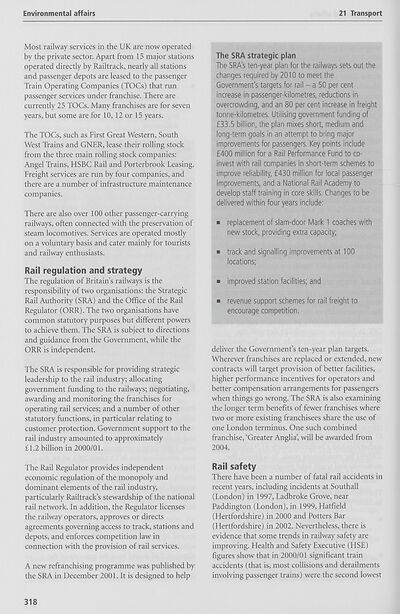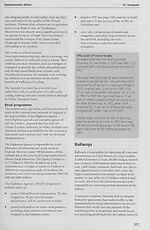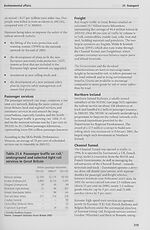Download files
Complete book:
Individual page:
Thumbnail gallery: Grid view | List view

Environmental affairs
21 Transport
Most railway services in the UK are now operated
by the private sector. Apart from 15 major stations
operated directly by Railtrack, nearly all stations
and passenger depots are leased to the passenger
Train Operating Companies (TOCs) that run
passenger services under franchise. There are
currently 25 TOCs. Many franchises are for seven
years, but some are for 10, 12 or 15 years.
The TOCs, such as First Great Western, South
West Trains and GNER, lease their rolling stock
from the three main rolling stock companies:
Angel Trains, HSBC Rail and Porterbrook Leasing.
Freight services are run by four companies, and
there are a number of infrastructure maintenance
companies.
There are also over 100 other passenger-carrying
railways, often connected with the preservation of
steam locomotives. Services are operated mostly
on a voluntary basis and cater mainly for tourists
and railway enthusiasts.
Rail regulation and strategy
The regulation of Britain’s railways is the
responsibility of two organisations: the Strategic
Rail Authority (SRA) and the Office of the Rail
Regulator (ORR). The two organisations have
common statutory purposes but different powers
to achieve them. The SRA is subject to directions
and guidance from the Government, while the
ORR is independent.
The SRA is responsible for providing strategic
leadership to the rail industry; allocating
government funding to the railways; negotiating,
awarding and monitoring the franchises for
operating rail services; and a number of other
statutory functions, in particular relating to
customer protection. Government support to the
rail industry amounted to approximately
£1.2 billion in 2000/01.
The Rail Regulator provides independent
economic regulation of the monopoly and
dominant elements of the rail industry,
particularly Railtrack’s stewardship of the national
rail network. In addition, the Regulator licenses
the railway operators, approves or directs
agreements governing access to track, stations and
depots, and enforces competition law in
connection with the provision of rail services.
A new refranchising programme was published by
the SRA in December 2001. It is designed to help
The SRA strategic plan
The SRA's ten-year plan for the railways sets out the
changes required by 2010 to meet the
Government's targets for rail - a 50 per cent
increase in passenger-kilometres, reductions in
overcrowding, and an 80 per cent increase in freight
tonne-kilometres. Utilising government funding of
£33.5 billion, the plan mixes short, medium and
long-term goals in an attempt to bring major
improvements for passengers. Key points include
£400 million for a Rail Performance Fund to co¬
invest with rail companies in short-term schemes to
improve reliability, £430 million for local passenger
improvements, and a National Rail Academy to
develop staff training in core skills. Changes to be
delivered within four years include:
■ replacement of slam-door Mark 1 coaches with
new stock, providing extra capacity;
■ track and signalling improvements at 100
locations;
■ improved station facilities; and
■ revenue support schemes for rail freight to
encourage competition.
deliver the Government’s ten-year plan targets.
Wherever franchises are replaced or extended, new
contracts will target provision of better facilities,
higher performance incentives for operators and
better compensation arrangements for passengers
when things go wrong. The SRA is also examining
the longer term benefits of fewer franchises where
two or more existing franchisees share the use of
one London terminus. One such combined
franchise, ‘Greater Anglia’, will be awarded from
2004.
Rail safety
There have been a number of fatal rail accidents in
recent years, including incidents at Southall
(London) in 1997, Ladbroke Grove, near
Paddington (London), in 1999, Hatfield
(Hertfordshire) in 2000 and Potters Bar
(Hertfordshire) in 2002. Nevertheless, there is
evidence that some trends in railway safety are
improving. Health and Safety Executive (HSE)
figures show that in 2000/01 significant train
accidents (that is, most collisions and derailments
involving passenger trains) were the second lowest
318
21 Transport
Most railway services in the UK are now operated
by the private sector. Apart from 15 major stations
operated directly by Railtrack, nearly all stations
and passenger depots are leased to the passenger
Train Operating Companies (TOCs) that run
passenger services under franchise. There are
currently 25 TOCs. Many franchises are for seven
years, but some are for 10, 12 or 15 years.
The TOCs, such as First Great Western, South
West Trains and GNER, lease their rolling stock
from the three main rolling stock companies:
Angel Trains, HSBC Rail and Porterbrook Leasing.
Freight services are run by four companies, and
there are a number of infrastructure maintenance
companies.
There are also over 100 other passenger-carrying
railways, often connected with the preservation of
steam locomotives. Services are operated mostly
on a voluntary basis and cater mainly for tourists
and railway enthusiasts.
Rail regulation and strategy
The regulation of Britain’s railways is the
responsibility of two organisations: the Strategic
Rail Authority (SRA) and the Office of the Rail
Regulator (ORR). The two organisations have
common statutory purposes but different powers
to achieve them. The SRA is subject to directions
and guidance from the Government, while the
ORR is independent.
The SRA is responsible for providing strategic
leadership to the rail industry; allocating
government funding to the railways; negotiating,
awarding and monitoring the franchises for
operating rail services; and a number of other
statutory functions, in particular relating to
customer protection. Government support to the
rail industry amounted to approximately
£1.2 billion in 2000/01.
The Rail Regulator provides independent
economic regulation of the monopoly and
dominant elements of the rail industry,
particularly Railtrack’s stewardship of the national
rail network. In addition, the Regulator licenses
the railway operators, approves or directs
agreements governing access to track, stations and
depots, and enforces competition law in
connection with the provision of rail services.
A new refranchising programme was published by
the SRA in December 2001. It is designed to help
The SRA strategic plan
The SRA's ten-year plan for the railways sets out the
changes required by 2010 to meet the
Government's targets for rail - a 50 per cent
increase in passenger-kilometres, reductions in
overcrowding, and an 80 per cent increase in freight
tonne-kilometres. Utilising government funding of
£33.5 billion, the plan mixes short, medium and
long-term goals in an attempt to bring major
improvements for passengers. Key points include
£400 million for a Rail Performance Fund to co¬
invest with rail companies in short-term schemes to
improve reliability, £430 million for local passenger
improvements, and a National Rail Academy to
develop staff training in core skills. Changes to be
delivered within four years include:
■ replacement of slam-door Mark 1 coaches with
new stock, providing extra capacity;
■ track and signalling improvements at 100
locations;
■ improved station facilities; and
■ revenue support schemes for rail freight to
encourage competition.
deliver the Government’s ten-year plan targets.
Wherever franchises are replaced or extended, new
contracts will target provision of better facilities,
higher performance incentives for operators and
better compensation arrangements for passengers
when things go wrong. The SRA is also examining
the longer term benefits of fewer franchises where
two or more existing franchisees share the use of
one London terminus. One such combined
franchise, ‘Greater Anglia’, will be awarded from
2004.
Rail safety
There have been a number of fatal rail accidents in
recent years, including incidents at Southall
(London) in 1997, Ladbroke Grove, near
Paddington (London), in 1999, Hatfield
(Hertfordshire) in 2000 and Potters Bar
(Hertfordshire) in 2002. Nevertheless, there is
evidence that some trends in railway safety are
improving. Health and Safety Executive (HSE)
figures show that in 2000/01 significant train
accidents (that is, most collisions and derailments
involving passenger trains) were the second lowest
318
Set display mode to:
![]() Universal Viewer |
Universal Viewer | ![]() Mirador |
Large image | Transcription
Mirador |
Large image | Transcription
The item on this page appears courtesy of Office for National Statistics and may be re-used under the Open Government Licence for Public Sector Information.
| Britain and UK handbooks > UK: The official yearbook of the United Kingdom of Great Britain and Northern Ireland > 2003 > (356) |
|---|
| Permanent URL | https://digital.nls.uk/204927738 |
|---|
| Attribution and copyright: |
|
|---|---|
| Description | Three volumes of 'UK: The official yearbook of the United Kingdom of Great Britain and Northern Ireland', published annually by the Office of National Statistics from 2002-2005. |
|---|---|
| Shelfmark | GII.11 SER |
| Description | Three titles produced by the British Government from 1954-2005 describing 'how Britain worked'. They are: 'Britain: An official handbook' (1954-1998), 'Britain: The official yearbook of the United Kingdom' (1999-2001), and 'UK: The official yearbook of the United Kingdom of Great Britain and Northern Ireland' (2002-2005). These 50 reports provide an overview of Britain's economic, social and cultural affairs, its environment, international relations, and the systems of government. They give an impartial summary of government policies and initiatives, and explain how public services are organised. |
|---|---|
| Additional NLS resources: |
|

